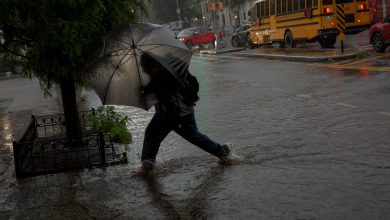How to Soften the Bullwhip Effect

Since early in the Covid-19 pandemic, economists have attributed product shortages and price spikes to the bullwhip effect, which is the chaos in the supply chain that’s created by hoarding and double- and triple-ordering. The bullwhip effect travels from the customer to the retailer to the distributor to the manufacturer, which furiously increases production to meet demand that turns out to be phantom.
My question: If the bullwhip effect is well known — and it certainly is, judging by the recent spate of Wall Street reports and news stories — why does it continue to wreak such havoc? Why don’t the various players along the supply chain recognize that the orders they’re getting aren’t a sign of lasting demand and adjust accordingly? Is there any hope of suppressing the bullwhip effect? I asked some experts that question and got some fascinating answers.
First, why this matters. The bullwhip effect is a major contributor to the current burst of inflation, which is the worst in decades. Consumer prices rose 6.8 percent in November from a year earlier, the most since 1982. The Producer Price Index for final demand rose 9.6 percent in November from a year earlier. The gyrating prices of lumber, iron and coal are a classic indication that a bullwhip is at work.
In theory, the bullwhip effect is nothing more than a short-term phenomenon. To the degree that prices of goods are inflated by an artificial spike in demand, they should recede quickly as production jumps and shortages become gluts. But there’s a risk that if the spike lasts a long time, people will start to expect higher inflation, which would become a self-fulfilling prophecy through higher wage demands and so on.
“There’s something of a race against time here because if this lasts, it’s going to feed into these classic wage-price spirals that will make the inflation much more persistent,” Hyun Song Shin, the economic adviser and head of research at the Bank for International Settlements in Basel, Switzerland, told me this week.
To see how the bullwhip effect works, think about how a whip cracks. A jerk of the handle sends a wave down the length of the whip. Because momentum is conserved and the mass of the part of the whip as you get toward the tip approaches zero, the velocity at the tip becomes extreme, exceeding the speed of sound. (I recommend this totally cool YouTube video of some whip experiments by Smarter Every Day.)
The same thing occurs in supply chains. An auto manufacturer gets nervous about Covid-19, so it preorders computer chips. The distributor interprets the order as a sign of increasing demand, so it orders more from the factory, with a safety cushion of extra orders. And so it continues, going all the way back to the chip fabricator and its suppliers at the far end of the whip, which are suddenly overwhelmed by a cascade of orders. And when products aren’t delivered on time, purchasing managers panic and place fresh orders, making the problem even worse.
The problem is thoroughly understood and well documented. In 1938 the economist Mordecai Ezekiel proposed the cobweb theorem of price setting in a U.S. Department of Agriculture bulletin. Farmers raise production when prices are high, but that causes prices to fall, so farmers cut production the next season, which causes prices to rise again. Depending on the shape of the supply and demand curves, prices can spiral inward on the cobweb toward stability or outward toward chaos.
In the 1950s Jay W. Forrester, a professor at the Massachusetts Institute of Technology, discovered the bullwhip effect (a.k.a. the Forrester effect) while studying how mistakes in inventory management produced a boom-bust cycle at a General Electric refrigerator plant in Lexington, Ky. He created a teaching tool originally called the refrigerator game but later called the beer game: Teams of students try to run a supply chain for beer production and delivery as efficiently as possible.
What’s hilarious about the beer game is that participants routinely fail — and badly. What’s less hilarious is that generations of students at business schools around the world who failed at the beer game are now making purchasing decisions at big, important companies and presumably failing once more.
The question, again, is why it’s so hard to fix this problem. Human nature is partly to blame. John Sterman, who holds the Jay W. Forrester chair at M.I.T.’s Sloan School of Management and runs the beer game there now, said it’s natural to hoard when there’s a risk of shortages. In a 2020 article he cited a cartoon from World War II in which a shopper who’s caught loading up on cans of food says: “I’m not hoarding. I’m just stocking up before the hoarders get here!”
The voice in the purchasing manager’s head that says “Order more” comes straight from the amygdala and limbic system, ancient parts of the brain that overwhelm the rational prefrontal cortex. “People are not very good at keeping track of the supply line,” Sterman told me. “The most salient information that they’ve got is, do they have inventory? The on-hand inventory plays an outsize role in conditioning their decisions.”
Sterman said that when he played the beer game with executives in an executive education program last week, one team racked up costs on paper of $190,000. Correct play should keep costs under $1,000. “Many of them said, ‘Absolutely, we’re living this right now,’” he told me. “One guy said, ‘This game was my whole career flashing before my eyes.’”
Information technology can help by offering greater transparency. If people can see that the goods they’ve ordered are en route, they’ll be less likely to double- or triple-order.
But tech isn’t a cure-all. Replacing emotional people with unemotional algorithms won’t solve the bullwhip effect because the effect isn’t just about emotions. It can be rational to overorder if you’re worried about shortages. And it can be rational for a producer to ramp up production to satisfy those orders if it wants to make some money and stay in the good graces of its customers.
What would work better is fixing incentives. Ted Stank, the faculty director of the Global Supply Chain Institute at the University of Tennessee, Knoxville, said that companies need to change how executives are paid, “so that everyone feels the pain of excess inventory.” That seems straightforward, but it’s not, he said. “There’s empire building within organizations. People will say, ‘I have autonomy. I don’t want metrics on my list of key performance indicators that I don’t have direct control over.’”
Aligning incentives to suppress the bullwhip effect is hardest in big organizations, Stank said. “If you have a 100,000-person organization operating across 150 countries, it just becomes really, really messy.”
Even if you get the incentives right within a company, you still have the problem of communications between companies, which don’t know how seriously to take each other’s orders. Shin, of the Bank for International Settlements, sees a role for government in facilitating communication between the various players. He likens the opportunity to how the Federal Reserve Bank of New York convened 14 banks and brokerage firms to invest in the hedge fund Long-Term Capital Management to save it from collapse in 1998.
The Biden administration is already doing that, to some extent. It has a task force for supply chain disruptions whose mission is to “act as an honest broker to encourage companies, workers and others to stop finger-pointing and start collaborating.”
Said Shin: “We typically don’t think about public authorities going in and directing resources on the real side of the economy. It’s a fine line. You don’t want to be in there shifting boxes of goods here and there. But to facilitate, that’s entirely legitimate.”
Elsewhere
Alabama is pretty good in football and UConn in women’s basketball, but it’s rare to find a dynasty as durable as the Pace University Federal Reserve Team, which last month won the national College Fed Challenge for the fifth time in eight years. Competitors in this event act as the Fed’s rate-setting Federal Open Market Committee, analyzing economic and financial conditions and formulating a monetary policy recommendation. Fed officials choose the winners. Eighty percent of the Pace team’s members this year are women; Yuwei Liu, a co-captain, hails from Beijing. Since 2004, students at Pace, which has campuses in Lower Manhattan and Westchester County, N.Y., have won the competition more than any other school. This year the University of Pennsylvania finished second and Dartmouth third.
Quote of the day
“Especially in digital markets where quickly achieving scale and amassing data is paramount, firms may determine that pursuing unfair or deceptive tactics is worth the cost of business, given that even an early lead can result in a long-term advantage.”
— Lina Khan, chair of the Federal Trade Commission, in a speech on Dec. 6
Have feedback? Send a note to [email protected].





